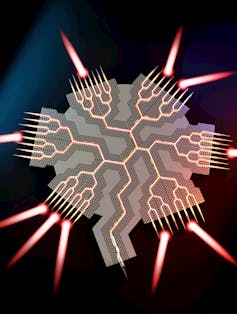Imagine a future where internet connections are not fast and reliable, even in crowded areas. This vision is getting closer to reality, thanks to new research into terahertz technology. These innovations are set to revolutionize wireless communications, especially as communications technology advances to the next generation of networks, 6G.
I’m an engineer with a focus on photonics, the study of how light and other electromagnetic waves are produced and detected. In this research, my colleagues and I have developed a silicon topological beamformer chip. Topological refers to the silicon material that helps direct terahertz waves, and beamformer refers to the purpose of the chip: to form terahertz waves into focused beams.
Terahertz frequencies are important for 6G, which the telecommunications industry is planning to roll out around the end of 2030. The frequencies used by modern wireless networks are increasing. Terahertz waves offer a solution by using the unoccupied part of the electromagnetic spectrum between microwaves and infrared. These higher frequencies can carry more data, making them suitable for future applications.

Wenhao Wang, Guillaume Ducournau, and Ranjan Singh
Our chip takes a terahertz signal from a single source and divides it into 54 sub-signals, which are routed through 184 sub-channels with 134 sharp curves. Each system can transmit and receive data at a speed of 40 to 72 gigabits per per second, many times faster than current 5G networks.
With the help of artificial intelligence, we designed a chip to have a small honeycomb pattern to generate terahertz waves. The video array sends powerful, focused beams that cover 360 degrees around the chip. This allows a phone or other wireless device anywhere around a Wi-Fi router or other chip-based device to receive a high-speed signal. We demonstrated the chip by splitting an HD video signal running into four output channels.
Beamformers in wireless networks
Terahertz waves have a shorter wavelength compared to the low-frequency signals used in 4G and 5G networks. Terahertz scanners solve this problem by carefully routing high-frequency signals to ensure they reach their destination without loss or damage.
Beamformers are essential to the next generation of wireless communications. Unlike most antennas that broadcast signals indiscriminately, transmitters only focus on certain areas of the signal, increasing efficiency and reliability. Our chip ensures that the columns will provide support in all directions.
This direct method not only increases the signal strength but also improves its quality, even at long distances. Beamformers are expected to play a key role in improving standard communications by reducing interference as the world adds billions of connected devices.
A future with terahertz light
The use of terahertz chips in everyday life is huge. For example, these tiny chips can download a high-definition 4K video in a fraction of a second compared to 11 minutes on today’s Wi-Fi, or support more realistic and immersive experiences without lag.
Beyond the fun, they can make real holographic communication into reality, where people appear as holograms. Smart cities can use this technology to seamlessly coordinate traffic and emergency responses, while healthcare can benefit from remote surgeries where doctors control robotic devices remotely.
The terahertz beamforming chip represents an important step on the way to fast, reliable wireless communication by overcoming the challenges of transmitting high-frequency signals.
#terahertz #control #chip #paves #superfast #internet #future